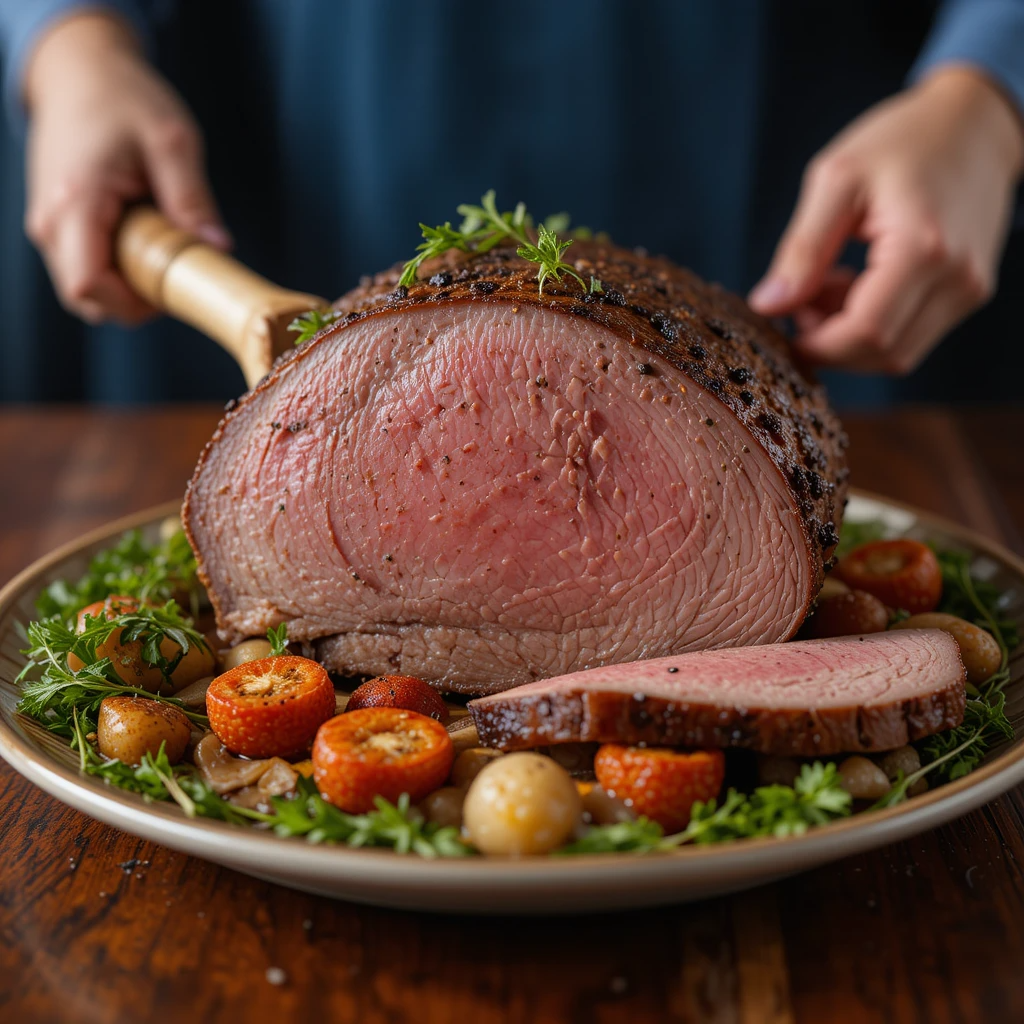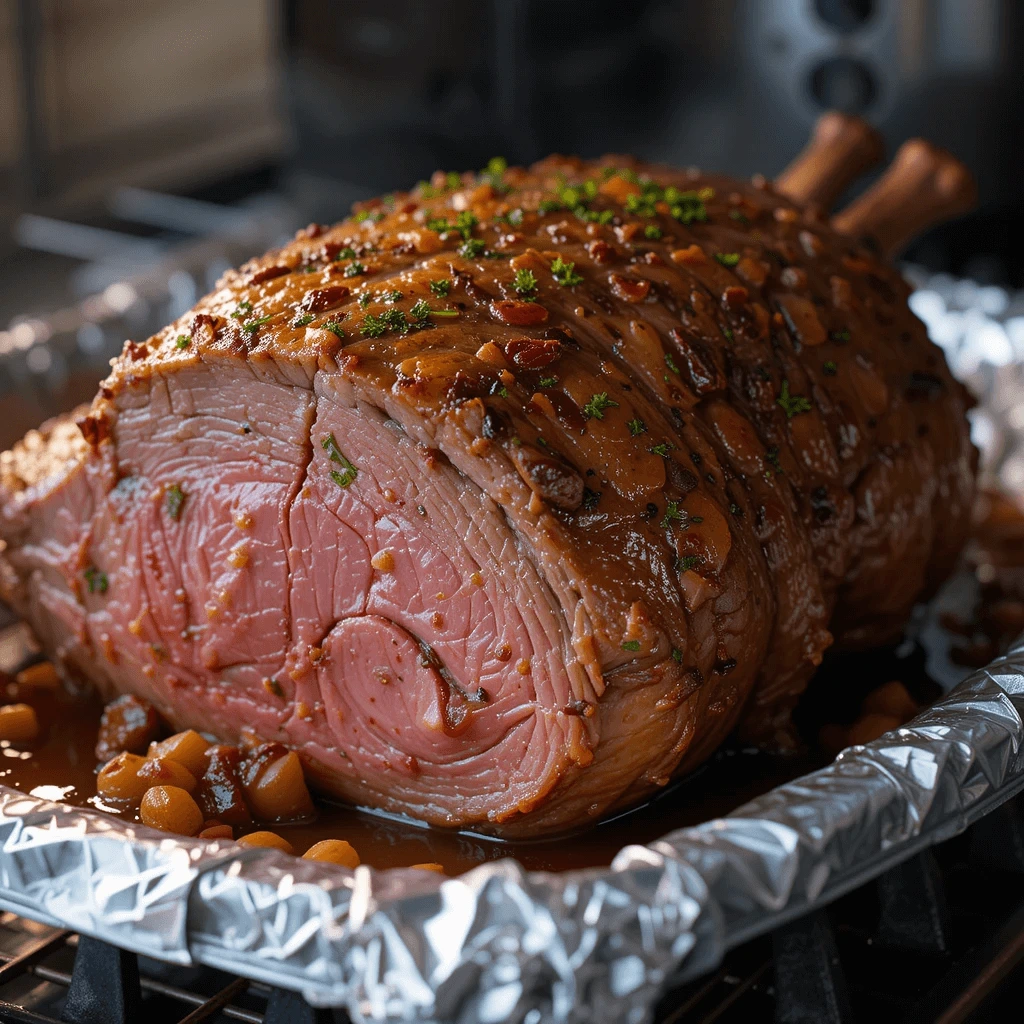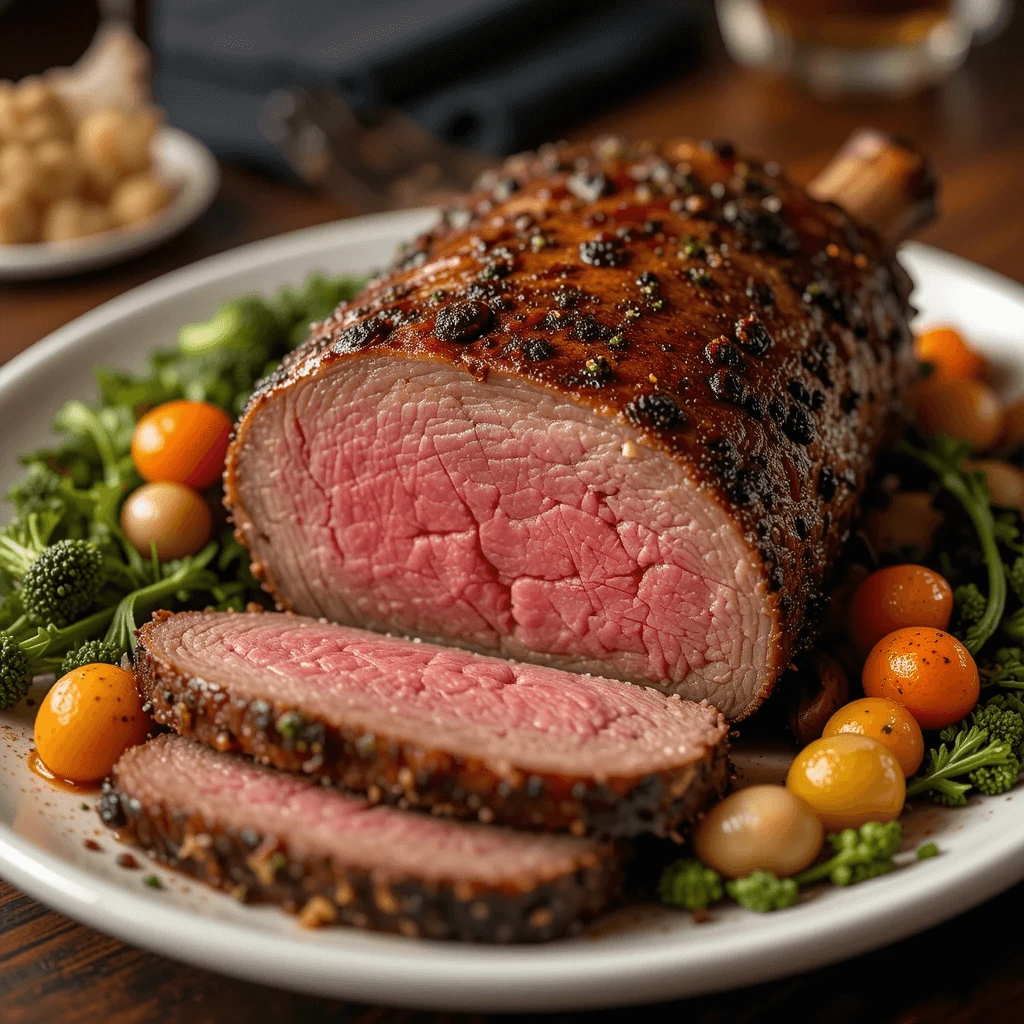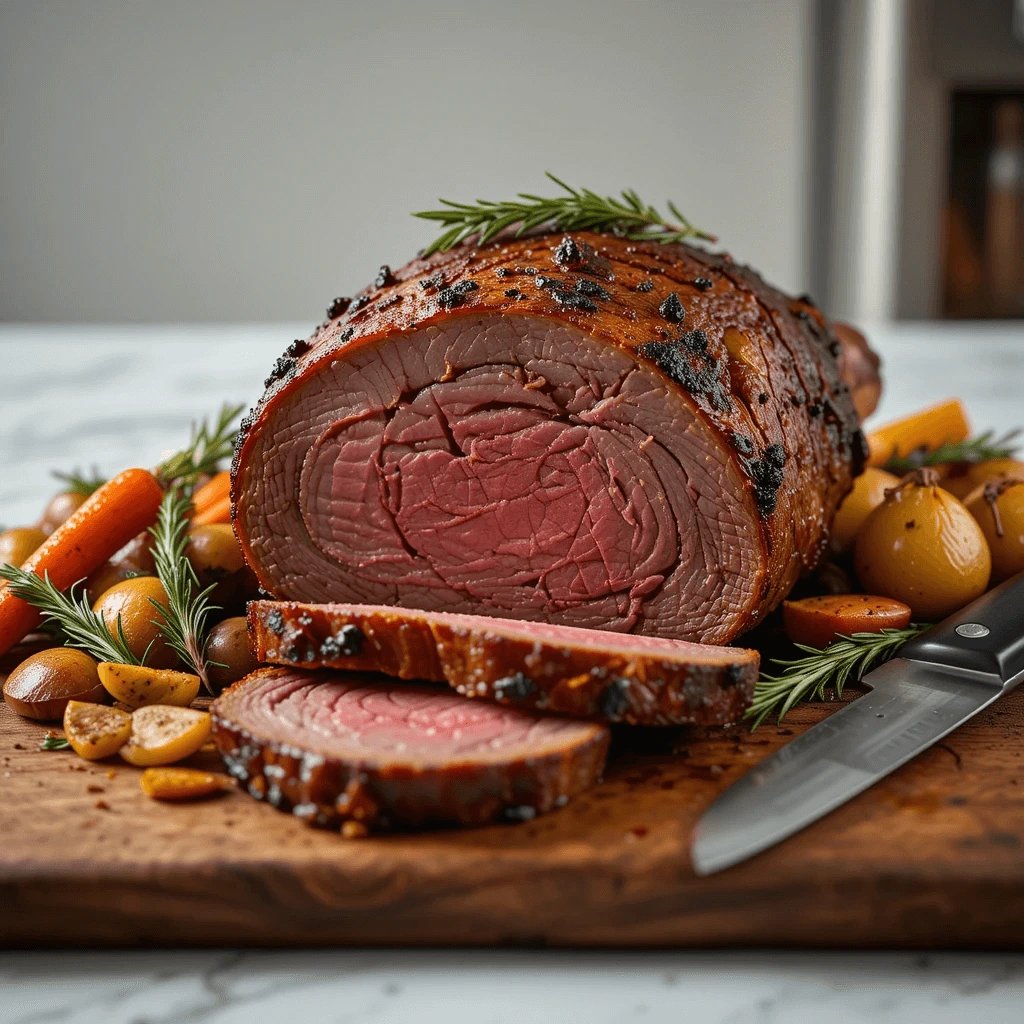If you’re looking for a budget-friendly yet delicious option for your next family dinner, a bottom round roast is the perfect choice. This cut of beef, taken from the rear of the cow, is lean and full of flavor, making it an excellent candidate for roasting. Often compared to other popular cuts like top round roast or sirloin, the bottom round roast stands out for its versatility and rich taste, especially when cooked properly.
Roasting a bottom round roast can result in a tender, juicy meal that rivals any premium cut of beef, and it’s ideal for feeding a crowd without breaking the bank. However, cooking this lean cut to perfection requires a little know-how to ensure it stays moist and flavorful.
In this post, I’ll guide you through a step-by-step recipe on how to cook a perfect bottom round roast. Whether you’re new to roasting or just looking to improve your technique, you’ll learn how to prepare, season, and roast a bottom round beef roast that’s juicy and tender every time.
What is a Bottom Round Roast and Why Choose It for Roasting?
Understanding Bottom Round Beef
- What is Bottom Round Beef?
- Bottom round is a lean cut from the rear of the cow.
- It’s part of the round primal, located in the back leg.
- Key Characteristics of Bottom Round Roast
- Lean with minimal fat, making it a healthier option.
- Known for its robust beef flavor, but can be tough without proper cooking.
- Differences Between Bottom Round and Other Roasts
- Compared to top round, bottom round is a bit tougher but more affordable.
- Unlike tender cuts like ribeye, it requires slow cooking to achieve tenderness.
- Best Cooking Methods for Bottom Round Roast
- Ideal for roasting, slow cooking, or braising to tenderize.
- Best when cooked low and slow or with moist heat for juiciness.
- Why Choose Bottom Round Roast for Your Recipe?
- A budget-friendly option that’s perfect for larger meals.
- When cooked right, it becomes tender and juicy with excellent flavor.
Benefits of Choosing Bottom Round Roas
- Budget-Friendly Option
- Bottom round roast is more affordable than premium cuts like ribeye or tenderloin.
- Great for feeding larger groups without breaking the bank.
- Lean and Healthier Choice
- With less fat, it’s a leaner cut of beef compared to others.
- Ideal for those looking for a healthier, low-fat beef option.
- Rich Beef Flavor
- Despite being lean, bottom round roast offers a deep, robust beef taste.
- Perfect for those who enjoy classic roast beef flavor.
- Versatile Cooking Options
- Can be roasted, slow-cooked, or braised, making it adaptable to different recipes.
- Works well with various seasonings and herbs, like rosemary and thyme.
- Great for Large Meals
- A large bottom round roast can serve many people, making it perfect for family dinners or special occasions.
- Ideal for meal prepping or creating leftovers for sandwiches.
Bottom Round Roast vs. Other Cuts for Roasting
- Bottom Round vs. Top Round Roast
- Both are lean cuts from the rear of the cow.
- Bottom round is tougher, but more affordable than top round.
- Top round is slightly more tender, but both require slow cooking for tenderness.
- Bottom Round vs. Ribeye Roast
- Ribeye is a premium cut with high fat marbling, making it more tender.
- Bottom round is leaner and less tender, but more budget-friendly.
- Ribeye offers a richer flavor due to its fat content, while bottom round has a firmer texture.
- Bottom Round vs. Sirloin Roast
- Sirloin roast is more tender and flavorful than bottom round.
- Sirloin tends to be pricier, while bottom round is ideal for a more economical roast.
- Both cuts can be roasted, but sirloin will cook faster and be juicier.
- Bottom Round vs. Chuck Roast
- Chuck roast is known for being more marbled with fat, making it ideal for slow cooking.
- Bottom round is leaner and better suited for roasting or braising.
- Chuck is more forgiving when slow-cooked for longer periods, while bottom round requires careful timing to avoid toughness.
- Why Choose Bottom Round Roast?
- Perfect for those who want a lean, affordable cut with a rich beef flavor.
- Requires proper seasoning and slow roasting to bring out its full potential.
How to Prepare and Season Your Bottom Round Roast for the Best Flavor

Best Seasonings and Rubs for a Perfect Roast
- Classic Herb Rub for Bottom Round Roast
- Rosemary, thyme, and garlic are classic herbs that complement beef perfectly.
- Use fresh or dried herbs for maximum flavor.
- Simple Salt and Pepper Rub
- A basic yet effective seasoning – kosher salt and freshly ground black pepper.
- Helps to enhance the natural flavor of the bottom round roast.
- Garlic and Onion Powder Rub
- Garlic and onion powder add depth to the flavor.
- Perfect for those who want a savory, aromatic roast without overpowering the beef.
- Spicy Rub with Paprika and Cayenne
- Paprika adds a smoky flavor while cayenne provides a subtle heat.
- Ideal for adding a bit of spice and complexity to your roast.
- Beef-Specific Steak Seasoning
- Use a pre-made steak seasoning blend that often includes salt, pepper, garlic, and various spices.
- These blends are designed specifically to bring out the best in roast beef.
- Marinades for Extra Tenderness
- Consider marinating the bottom round roast with a mix of olive oil, soy sauce, and Worcestershire sauce.
- Marinades can help tenderize the meat and infuse extra flavor.
- Dry Rubs vs. Marinades
- Dry rubs form a crust on the roast, locking in flavors.
- Marinades are great for extra moisture and flavor infusion.
- Seasoning Tips for Even Flavor
- Rub the seasoning generously and let the roast rest for 30 minutes before cooking.
- Make sure to season all sides of the roast evenly for consistent taste.
Marinating vs. Dry Rub: Which Works Best for Bottom Round Roast?
- Marinating for Tenderness and Flavor
- Marinating infuses the beef with moisture and flavor.
- Ideal for tougher cuts like bottom round, as it helps tenderize the meat.
- Best when marinated for 4-12 hours for maximum flavor penetration.
- Best Marinade Ingredients
- Use acidic ingredients like vinegar or citrus to break down the meat fibers.
- Combine with olive oil, soy sauce, garlic, and herbs for balanced flavor.
- A good marinade enhances both flavor and tenderness.
- Dry Rub for a Flavorful Crust
- Dry rubs create a savory, flavorful crust on the outside of the roast.
- Perfect for adding spices and herbs directly to the surface.
- Works well for roasts that don’t need as much tenderness, but benefit from flavor depth.
- Best Dry Rub Ingredients
- Use a mix of salt, pepper, garlic powder, paprika, and dried herbs like rosemary or thyme.
- A dry rub enhances the beef’s natural flavors without adding moisture.
- When to Use a Marinade vs. Dry Rub
- Marinades are ideal for tougher cuts like bottom round, requiring tenderization.
- Dry rubs are better for roasts where a flavorful crust and seasoning are desired.
- For maximum tenderness and flavor, consider marinating first, then applying a dry rub before roasting.
- Which is Best for Bottom Round Roast?
- If tenderness is a priority, marinating is the best choice.
- For a crispy, flavorful exterior, a dry rub works great.
- Combining both can yield a juicy, flavorful roast with a perfect crust.
How to Trim and Prep the Bottom Round Roast for Roasting
- Remove Excess Fat
- Bottom round roast is lean, but may have a fat cap.
- Trim the fat to about 1/4 inch to prevent greasiness while roasting.
- Leave a thin layer to keep the roast moist during cooking.
- Trim Silver Skin
- Silver skin is a tough, silvery membrane that won’t break down during cooking.
- Use a sharp knife to remove it, ensuring tender, flavorful slices.
- Shape the Roast Evenly
- If the roast is uneven, trim it to ensure even cooking.
- A uniform shape helps the roast cook more consistently, avoiding dry or overcooked areas.
- Tie the Roast with Twine (Optional)
- Tying the roast helps it hold its shape while cooking.
- Use kitchen twine to tie the roast at 1-2 inch intervals for even roasting.
- Bring to Room Temperature Before Cooking
- Let the roast sit at room temperature for 30-60 minutes before cooking.
- This helps the meat cook more evenly and reduces the risk of dryness.
- Season Well Before Roasting
- Rub the trimmed roast generously with your chosen seasonings or rub.
- Apply seasoning evenly across all sides for a flavorful crust.
- Prep for Cooking Method
- Decide if you will slow roast, braise, or cook using another method.
- Adjust the preparation (e.g., for slow roasting, you may want to add vegetables or broth around the roast).
Step-by-Step Guide to Cooking a Perfect Bottom Round Roast in the Oven

Preparing the Roast: Bring to Room Temperature and Preheat Oven
- Bring the Bottom Round Roast to Room Temperature
- Take the roast out of the fridge 30-60 minutes before cooking.
- Allowing it to come to room temperature helps it cook more evenly.
- Avoids the roast from becoming tough by reducing the temperature shock when cooking.
- Why Room Temperature Matters
- Cold meat can cook unevenly, leading to dry or overcooked areas.
- Room temperature ensures that the roast cooks at a consistent rate throughout.
- Preheat the Oven
- Set the oven to 325°F (165°C) for slow roasting.
- Preheating ensures the roast starts cooking immediately and evenly.
- A preheated oven promotes better browning and flavor development.
- Timing Your Roast Preparation
- While the roast comes to room temperature, preheat the oven simultaneously.
- This minimizes any wait time before placing the roast in the oven.
- Why Preheating is Crucial
- A hot oven helps lock in juices, keeping the bottom round roast moist.
- Starting at the right temperature creates a flavorful crust on the roast.
Roast Beef Cooking Times and Temperature Guide
- Preheat the Oven to 325°F (165°C)
- This temperature ensures slow, even cooking for a tender roast.
- Ideal for a bottom round roast to retain moisture and flavor.
- Cooking Time Per Pound
- Roast at 20-25 minutes per pound for a perfectly cooked bottom round roast.
- Adjust based on roast size and desired doneness.
- Target Internal Temperatures for Different Doneness
- Rare: 120-125°F (49-52°C)
- Medium-Rare: 125-130°F (52-54°C)
- Medium: 130-140°F (54-60°C)
- Medium-Well: 140-150°F (60-66°C)
- Well-Done: 150°F+ (66°C+)
- How to Check Internal Temperature
- Use a meat thermometer inserted into the thickest part of the roast.
- Avoid touching bone to get an accurate reading.
- Resting the Roast After Cooking
- Remove the roast when it’s 5-10°F below the target temperature.
- Let it rest for 15-20 minutes to allow juices to redistribute.
- Adjust for Different Roast Sizes
- Larger roasts may take longer to cook.
- Always check the internal temperature to ensure perfect doneness.
- Why Consistent Temperature is Important
- Consistent oven temperature prevents uneven cooking.
- Ensures the roast is perfectly cooked from edge to center.
Oven Roasting Techniques for a Tender, Juicy Bottom Round Roast
- Use Low and Slow Cooking
- Roast the bottom round at 325°F (165°C) for tender results.
- Slow roasting allows the meat to cook evenly and retain moisture.
- Place Fat Side Up
- Position the roast with the fat cap on top.
- This helps the fat melt into the roast, basting it and keeping it juicy.
- Add Moisture for Extra Tenderness
- Consider adding broth or water to the roasting pan.
- Moisture in the pan helps prevent the roast from drying out during cooking.
- Cover with Foil (Optional)
- Covering the roast with foil during the first part of roasting traps moisture.
- Remove foil in the final 30 minutes to allow browning and crisping.
- Monitor Internal Temperature
- Use a meat thermometer to check the roast’s internal temperature.
- Aim for 125-130°F (52-54°C) for medium-rare or adjust based on preference.
- Baste Occasionally
- Baste the roast every 30 minutes with its own juices or broth.
- This helps maintain moisture and creates a flavorful crust.
- Rest After Roasting
- Let the roast rest for 15-20 minutes after removing it from the oven.
- Resting allows juices to redistribute, ensuring a moist, tender roast.
- Roast in a Shallow Pan
- Use a shallow roasting pan to allow air circulation.
- This helps the roast cook evenly and promotes a crisp, flavorful exterior.
- Avoid Overcooking
- Keep an eye on the internal temperature to prevent overcooking.
- Overcooking can lead to a dry, tough roast, especially with lean cuts like bottom round.
Common Mistakes to Avoid When Roasting Bottom Round Beef
Overcooking or Undercooking the Roast
- Consequences of Overcooking
- Overcooking the bottom round roast makes it dry and tough.
- Lean cuts like bottom round are more prone to drying out if overcooked.
- The texture becomes stringy and less enjoyable.
- Signs of Overcooking
- A roast that’s too well-done will have a tough, chewy texture.
- The internal temperature will exceed the target by more than 10°F.
- The juices run clear, indicating the meat has lost moisture.
- How to Avoid Overcooking
- Always use a meat thermometer to track the roast’s internal temperature.
- Remove the roast from the oven 5-10°F before reaching the desired doneness.
- Let the roast rest after cooking to retain juices.
- Consequences of Undercooking
- Undercooked beef is tough and lacks flavor.
- The roast will be cold in the center, and the texture will be unappetizing.
- Potential food safety risks if the meat is too rare.
- Signs of Undercooking
- The roast feels too soft or squishy when touched.
- The internal temperature is below the desired level (e.g., under 120°F for rare).
- Meat looks raw or only partially cooked on the inside.
- How to Avoid Undercooking
- Use a meat thermometer to ensure the roast reaches the proper internal temperature.
- Don’t rely on cooking time alone, as it varies based on roast size.
- Always check the temperature before removing from the oven.
- Perfect Cooking Balance
- Aim for the right internal temperature for your preferred doneness.
- Let the roast rest to ensure even cooking and moisture retention.
- Proper cooking times and techniques result in a tender, juicy roast.
Skipping the Resting Time After Roasting
- Importance of Resting the Roast
- Resting allows juices to redistribute throughout the meat.
- Without resting, the juices are lost when slicing, making the roast dry.
- Resting ensures the bottom round roast remains tender and flavorful.
- How Resting Affects Texture
- Slicing immediately after roasting results in a loss of moisture.
- The roast will be tougher and less juicy without proper resting time.
- The texture improves when the fibers have time to relax after cooking.
- Ideal Resting Time
- Let the bottom round roast rest for 15-20 minutes after removing it from the oven.
- The roast will continue to cook slightly from residual heat during this time.
- Resting helps achieve even cooking, preventing overcooking in some areas.
- Resting Time vs. Doneness
- Resting time doesn’t affect the roast’s internal temperature significantly.
- It allows for a more even temperature throughout the meat.
- Helps maintain the roast’s juiciness for better taste and texture.
- What Happens If You Skip Resting?
- Skipping the resting time leads to dry, chewy slices.
- The roast will lose its natural juices, making it less flavorful.
- The meat’s tenderness is compromised when the resting period is skipped.
- How to Rest the Roast
- Simply cover the roast loosely with foil while resting.
- Don’t wrap tightly, as it may trap steam and affect the crust.
- Let it sit undisturbed for the full resting time for the best results.
Not Using a Meat Thermometer
- Why a Meat Thermometer is Essential
- A meat thermometer ensures your bottom round roast is cooked to the right doneness.
- It eliminates guesswork, helping to avoid undercooking or overcooking.
- Precise temperature readings give you control over the roast’s texture and flavor.
- Risks of Not Using a Meat Thermometer
- Without a thermometer, you rely on cooking time, which can be inaccurate.
- Under or overcooking the roast may lead to tough, dry, or chewy meat.
- The roast may not reach a safe internal temperature, leading to potential food safety issues.
- How to Use a Meat Thermometer Correctly
- Insert the thermometer into the thickest part of the roast, avoiding bone or fat.
- Check the temperature frequently, especially near the end of cooking.
- For bottom round roast, target 125-130°F for medium-rare, and adjust for your desired doneness.
- Benefits of Accurate Temperature Control
- A thermometer helps you achieve perfect, juicy, and tender results.
- You can monitor the roast closely to hit your exact preferred doneness.
- Reduces the risk of serving an undercooked or overcooked roast.
- Thermometer Types to Use
- Instant-read thermometers provide quick, accurate readings.
- Probe thermometers with timers allow for continuous monitoring without opening the oven.
- Both types offer convenience and precision, ensuring the best roast results.
- Why Guessing Is Risky
- Relying on time alone doesn’t account for variables like roast size or oven accuracy.
- Guessing can lead to dry, tough meat or unevenly cooked portions.
- A thermometer guarantees your roast is perfectly cooked every time.
Serving and Pairing Your Bottom Round Roast

How to Slice a Bottom Round Roast for the Perfect Cut
- Rest the Roast Before Slicing
- Let the bottom round roast rest for 15-20 minutes after roasting.
- Resting ensures juices stay inside the meat, making it tender and juicy.
- Avoid slicing immediately to prevent losing moisture.
- Use a Sharp Knife
- A sharp carving knife or chef’s knife makes clean, precise cuts.
- A dull knife can tear the meat, leading to uneven slices.
- Sharpen your knife before slicing to ensure the best results.
- Slice Against the Grain
- Identify the grain (the direction of muscle fibers) and slice across it.
- Cutting against the grain shortens the fibers, making the meat more tender.
- This method prevents tough, chewy slices, especially for lean cuts like bottom round.
- Make Even Slices
- Aim for even, uniform slices, about 1/4 to 1/2 inch thick.
- Consistent thickness ensures the roast cooks and slices evenly.
- Even slices are ideal for presentation and help with portion control.
- Use a Carving Fork for Stability
- Hold the roast steady with a carving fork or tongs while slicing.
- This prevents the roast from moving and makes slicing safer and easier.
- A stable roast gives you better control over your knife.
- Consider Slicing in the Same Direction as the Roast
- If the roast has a particularly long shape, slice from one end to the other.
- This can help create uniform portions and improve ease of slicing.
- Serve Immediately
- Serve the slices right after cutting to retain warmth.
- Freshly sliced bottom round roast ensures a better eating experience.
Delicious Side Dishes to Serve with Roast Beef
- Classic Mashed Potatoes:
- Creamy mashed potatoes balance the rich flavors of roast beef.
- Add butter, cream, and seasoning for extra indulgence.
- Roasted Vegetables:
- Roasting carrots, parsnips, and Brussels sprouts enhances their natural sweetness.
- Toss with olive oil, salt, and pepper for a simple, flavorful side.
- Yorkshire Pudding:
- A classic side that soaks up gravy beautifully.
- Light and fluffy, it adds texture and flavor to your roast.
- Garlic Green Beans:
- Sautéed green beans with garlic and butter offer a crisp, fresh side.
- Add toasted almonds or parmesan for extra crunch and flavor.
- Creamed Spinach:
- Creamy spinach adds richness and complements the tender roast.
- A sprinkle of nutmeg or garlic enhances the flavor.
- Roast Potatoes:
- Crispy roast potatoes are perfect with roast beef.
- Season with rosemary, thyme, and garlic for added aroma and flavor.
- Cauliflower Gratin:
- Cheesy, creamy cauliflower gratin adds luxury to the meal.
- The delicate crunch of cauliflower pairs beautifully with the rich cheese sauce.
- Crispy Salad with Balsamic Vinaigrette:
- A fresh, crisp salad with tangy balsamic vinaigrette contrasts the richness of the beef.
- Add roasted nuts or cheese for extra texture.
- Dinner Rolls or Bread:
- Soft, warm rolls or crusty bread are perfect for soaking up gravy and juices.
- A simple yet essential side to complete the roast beef meal.
Creative Ways to Use Leftover Bottom Round Roast
- Beef Sandwich:
- Slice leftover roast thinly and pile on a crusty roll.
- Add condiments like mustard, horseradish, or cheese for flavor.
- A simple and satisfying meal.
- Beef Stew or Soup:
- Cut leftover roast into cubes and simmer in broth with vegetables.
- Perfect for a hearty, comforting dish.
- Add herbs and seasonings for extra flavor.
- Beef Tacos or Burritos:
- Shred leftover roast beef for taco or burrito filling.
- Top with salsa, avocado, and cilantro for freshness.
- A fun and customizable meal.
- Beef Salad:
- Slice leftover roast beef and add to a fresh salad.
- Toss with vinaigrette or creamy dressing.
- Add roasted veggies or cheese for a filling option.
- Beef Hash:
- Dice roast beef and fry with potatoes and onions.
- Season with herbs and spices.
- Serve with eggs for a hearty breakfast.
- Beef Stir-Fry:
- Thinly slice leftover roast and stir-fry with veggies.
- Add soy sauce, garlic, and ginger for an Asian twist.
- Stir-fry with rice or noodles for a quick, flavorful meal.
- Beef and Cheese Quesadillas:
- Use leftover roast beef as quesadilla filling.
- Add sautéed onions and peppers for flavor.
- Serve with sour cream, salsa, or guacamole.
- Beef Pot Pie:
- Combine leftover roast with vegetables and gravy.
- Bake in a pie crust for a comforting pot pie.
- A warm, satisfying dish.
- Beef Fried Rice:
- Chop roast beef and toss into fried rice with veggies.
- Add soy sauce, eggs, and green onions for flavor.
- A quick and easy meal.
Recap of the Key Steps for Cooking a Perfect Bottom Round Roast
- Choose the Right Cut: Start with a high-quality bottom round roast for the best results.
- Season and Prepare: Season the roast with your favorite rub or marinade, and bring it to room temperature before roasting.
- Preheat the Oven: Make sure the oven is preheated to 325°F (165°C) for optimal slow roasting.
- Monitor the Temperature: Use a meat thermometer to ensure the roast reaches your preferred doneness (125-130°F for medium-rare).
- Rest the Roast: After removing from the oven, let the roast rest for 15-20 minutes to allow juices to redistribute.
- Slice Against the Grain: For the perfect tender slices, always cut the roast against the grain.
- Enjoy: Pair with your favorite sides for a delicious, satisfying meal!
Try the Recipe and Enjoy a Tender, Flavorful Roast Beef Meal
Now that you know how to cook a perfect bottom round roast, it’s time to give this recipe a try! With these simple steps, you’ll enjoy a tender, juicy roast beef meal that will impress your family and friends. Whether it’s for a weeknight dinner or a special occasion, this recipe is sure to become a staple in your kitchen.
Leave a Comment and Share Your Thoughts
Did you try the recipe? I’d love to hear about your experience! Leave a comment below with any tips, questions, or variations you tried. Your feedback can help others make their perfect roast too!
Share with Friends and Family
If you found this recipe helpful, why not share it with your friends or family? It’s always great to spread the joy of cooking a tender and flavorful roast beef. Let’s all enjoy delicious meals together!

